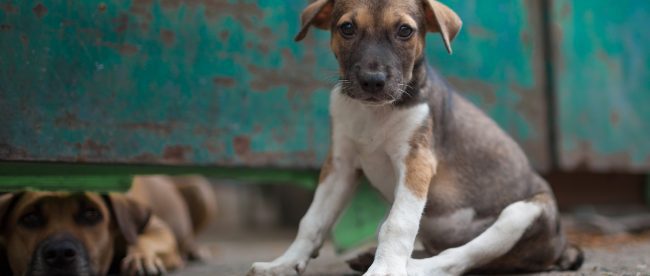Overcoming trauma caused by seeing animal cruelty on social media
How can you overcome the distress that accidentally seeing animal cruelty causes you when scrolling through social media?
Dustin Kieschnick and Katie Lawlor from the Oxford Centre for Animal Ethics talk about how to cope with witnessing animal cruelty on social media, especially when you want to help.
For a long time, animal welfare organisations and charities have used graphic images to shock people into action. Before social media, their TV commercials and advertisements in newspapers and magazines did not shy away from depicting and documented brutality against animals. Now, a scroll through social media can easily expose you to some shocking scenes. Especially if your online activity triggers certain animal welfare-related algorithms.
You’ll be pleased to know that we’ve purposely gone easy on the images for this article to avoid traumatising anyone. So you can read on safely.
…prolonged exposure to traumatic content can lead to compassion fatigue, burnout, and even post-traumatic stress disorder (PTSD)
The aim of these images has always been the same: to raise awareness, usually for vital fundraising, legal purposes or to get news coverage. But for social media followers, prolonged exposure to traumatic content can lead to compassion fatigue, burnout, and even post-traumatic stress disorder (PTSD). When we are confronted with an animal in danger or learn of animal cruelty, we may experience an immediate and overwhelming sense of trauma.
What makes something ‘traumatic’?
The Psychiatric Diagnostic Manual (DSM) describes trauma as exposure to an event that is sustained as physically and/or emotionally harmful. And which has potentially lasting adverse effects on our lives.
Trauma can occur through experiencing something directly, witnessing something happen to someone else, or repeated exposure to the distressing details of an event or series of events. Many clinicians are now making the case that the DSM definition should include harm to companion and wild animals as well as people.
Exposure to trauma takes several forms, including photos and videos. Social media platforms often provide less-filtered, more raw descriptions, accompanied by graphic imagery. Even when we witness this at a distance via our electronic devices, we are still exposed to traumatic content. And it can affect us mentally and emotionally.

Trauma is complex
Trauma can affect different people in different ways. The impact is influenced by our own histories of trauma, our ethics and values, and our sense of connectedness to the affected. As we witness an animal’s suffering, perhaps we put ourselves in their situation. Perhaps we feel safe in their company and want to ensure they are safe and protected too.
As we witness an animal’s suffering, perhaps we put ourselves in their situation
Perhaps we feel most at peace in nature, and believe that peace should extend to them, especially in their natural habitats. Or perhaps we have trained extensively in a related profession and feel painfully inadequate when we can’t use our talents and resources to save and heal them.
The cognitive processes in our brains that enable us to take action are often not straightforward, which makes trauma challenging. We may experience detrimental psychological effects that block our attempts to help, even though we cannot bear to see animals in pain.
The role of emotions
Psychologists use two terms to explain the emotions you might be feel when you see graphic depictions of animal cruelty.
The first are natural emotions, which humans experience universally. Sadness, loneliness, isolation, fear, hopelessness, anger, confusion and disbelief all fall into this category. While reflection on a traumatic event evokes natural emotions, they should become more bearable with time.
The second type of post-trauma emotions are manufactured emotions. These feelings are derived from our personal interpretation of the event. For example, if we believe that we should have been able to save the animal, or we didn’t do enough to protect them, we might feel damaging emotions, such as shame and worthlessness.
Mental health in a digital age
New research indicates a dose-response relationship in trauma. This means that the more you are exposed to traumatic content, including online scenes of animal cruelty, the more at risk you are of being affected.
Some people can recover and heal from exposure without any treatment. But others may experience acute and persistent mental health conditions.
For these people, vicarious traumatisation can occur. This is when trauma symptoms that arise from repeated exposure to traumatic content can lead to symptoms, such as disheartening changes in one’s worldview, inability to emotionally regulate and questioning of self-identity.
Care for yourself, as well as animals
To navigate this challenging digital landscape, it is crucial to balance awareness with the potential negative effects of overexposure. By recognising the impact of trauma, the animal welfare community can adopt strategies to promote mental well-being, such as virtual peer support groups. A study with US-based veterinarians highlighted the value of consistent, accessible and supportive communities where thoughts and feelings are normalised and validated, fostering camaraderie and empathy.
When we’ve been traumatised by exposure to animal cruelty on social media, there are proactive steps we can take to mitigate the risk of lasting distressing effects.
…viewing this type of violent content can immediately affect our thoughts, mood and behaviour
First and foremost, we need to understand that viewing this type of violent content can immediately affect our thoughts, mood and behaviour. We may find ourselves wanting to react impulsively, whether that’s further engaging with the content, no matter how awful, or turning away.
The coping checklist
A beneficial coping skill we can implement in real-time is to pause for a check-in by asking yourself the following questions:
- Do you have any intense feelings after viewing animal cruelty content?
- Do any aspects of this material remind you of previous upsetting events in your life, either personally or professionally?
- Are you finding yourself preoccupied by what you saw hours or days after you first viewed it?
- Are you experiencing any uncomfortable physical symptoms in response to what you saw, such as pain, tension, irritability or restlessness?
This exercise can help you cultivate a deeper awareness of your personal response to traumatic imagery.
If you responded yes to any of these questions, give yourself time and space to process — and then release — what you witnessed. There are several healthy ways to do this: journaling; talking to a trusted loved one or colleague; spending time in nature; and exercise.
Establish a strategy for putting boundaries on your involvement with graphic campaigns or programming, while finding a balance with those that inspire and motivate you. Together, these three steps can sustain your commitment to animal welfare, while keeping you grounded and in control of your interactions.
ABOUT THE AUTHORS


Dustin Kieschnick and Katie Lawlor presented an earlier version of this paper at the Annual Oxford Animal Ethics Summer School on Animals and the Media: Communicating Ethical Perspectives on Animals held at Merton College, University of Oxford, August 7-10, 2023: Animals and Media – Oxford Centre for Animal Ethics (oxfordanimalethics.com). The Oxford Centre for Animal Ethics is an independent centre pioneering ethical perspectives on animals through academic research, teaching, and publication. The Centre comprises more than 100 academic Fellows worldwide.
Web: www.oxfordanimalethics.com/home
Instagram: @oxfordanimalethics
YouTube: https://www.youtube.com/@oxfordanimalethics




Leave a comment